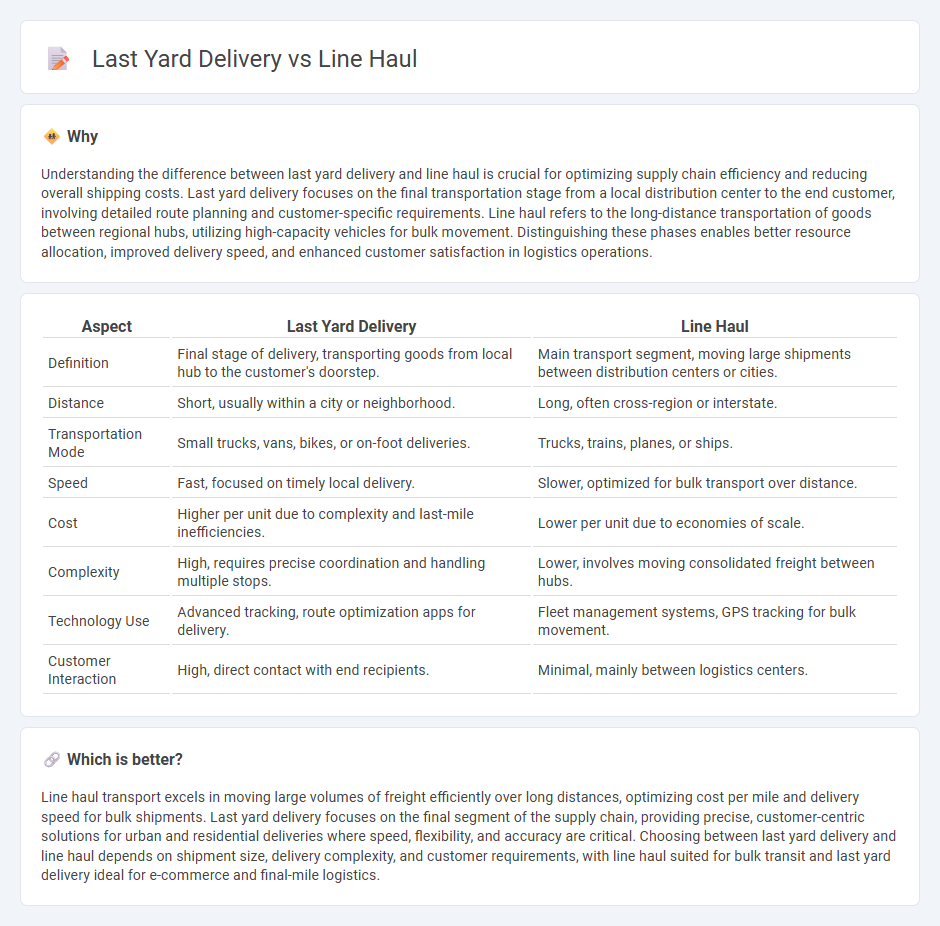
Last yard delivery focuses on the final segment of supply chain logistics, involving the transportation of goods from local distribution centers directly to the end customer. Line haul covers the long-distance transportation of freight between major hubs, utilizing trucks, trains, or ships to move bulk shipments efficiently. Explore the intricacies of last yard delivery and line haul to optimize your logistics strategy.
Why it is important
Understanding the difference between last yard delivery and line haul is crucial for optimizing supply chain efficiency and reducing overall shipping costs. Last yard delivery focuses on the final transportation stage from a local distribution center to the end customer, involving detailed route planning and customer-specific requirements. Line haul refers to the long-distance transportation of goods between regional hubs, utilizing high-capacity vehicles for bulk movement. Distinguishing these phases enables better resource allocation, improved delivery speed, and enhanced customer satisfaction in logistics operations.
Comparison Table
| Aspect | Last Yard Delivery | Line Haul |
|---|---|---|
| Definition | Final stage of delivery, transporting goods from local hub to the customer's doorstep. | Main transport segment, moving large shipments between distribution centers or cities. |
| Distance | Short, usually within a city or neighborhood. | Long, often cross-region or interstate. |
| Transportation Mode | Small trucks, vans, bikes, or on-foot deliveries. | Trucks, trains, planes, or ships. |
| Speed | Fast, focused on timely local delivery. | Slower, optimized for bulk transport over distance. |
| Cost | Higher per unit due to complexity and last-mile inefficiencies. | Lower per unit due to economies of scale. |
| Complexity | High, requires precise coordination and handling multiple stops. | Lower, involves moving consolidated freight between hubs. |
| Technology Use | Advanced tracking, route optimization apps for delivery. | Fleet management systems, GPS tracking for bulk movement. |
| Customer Interaction | High, direct contact with end recipients. | Minimal, mainly between logistics centers. |
Which is better?
Line haul transport excels in moving large volumes of freight efficiently over long distances, optimizing cost per mile and delivery speed for bulk shipments. Last yard delivery focuses on the final segment of the supply chain, providing precise, customer-centric solutions for urban and residential deliveries where speed, flexibility, and accuracy are critical. Choosing between last yard delivery and line haul depends on shipment size, delivery complexity, and customer requirements, with line haul suited for bulk transit and last yard delivery ideal for e-commerce and final-mile logistics.
Connection
Last yard delivery and line haul are interconnected key components of the logistics supply chain, where line haul refers to the long-distance transportation of goods between major cities or distribution centers, and last yard delivery involves the final movement of these goods from local hubs to the end customer. Efficient coordination between line haul and last yard delivery ensures timely and cost-effective fulfillment, minimizing delays and optimizing resource utilization. Advanced tracking and route planning technologies enhance visibility across both stages, improving overall supply chain performance and customer satisfaction.
Key Terms
Transit Time
Line haul transportation covers the long-distance movement of goods between major hubs, often spanning hundreds of miles and taking several hours to several days. Last yard delivery refers to the final phase, where shipments are transported from a local distribution center to the end consumer, typically completed within hours. Explore further to understand how transit time impacts overall supply chain efficiency.
Distribution Center
Line haul involves long-distance transportation of goods between distribution centers, optimizing bulk movement and reducing transit times across major routes. Last yard delivery, also known as last mile delivery, focuses on the final step from distribution centers to the end customer, emphasizing speed, accuracy, and local logistics efficiency. Explore deeper insights into optimizing distribution center operations for seamless line haul and last yard delivery.
Final Mile
Line haul transportation involves moving goods in bulk over long distances between distribution centers, focusing on efficiency and cost reduction. Last yard delivery, often termed the final mile, refers to the crucial step of delivering products from a local hub directly to the customer's doorstep, emphasizing speed and accuracy to enhance customer satisfaction. Explore in-depth strategies and technologies transforming final mile logistics for a competitive advantage.
Source and External Links
Line Haul Meaning in Trucking - FreightRun.com - Line haul refers to the movement of goods over long distances between major hubs, using various transport modes like trucks, trains, planes, or ships, typically involving bulk cargo transfers between two points on a defined route.
LINE-HAUL Definition & Meaning | Dictionary.com - Line-haul is the transport of freight for long distances or between distant cities, typically by truck from terminal to terminal.
What is a Line Haul? (How To Become and Responsibilities) - Indeed - A line haul driver operates commercial vehicles to transport goods from one location to another, usually making shorter trips than long haul drivers while ensuring safe loading, routing, and delivery of freight.
 dowidth.com
dowidth.com